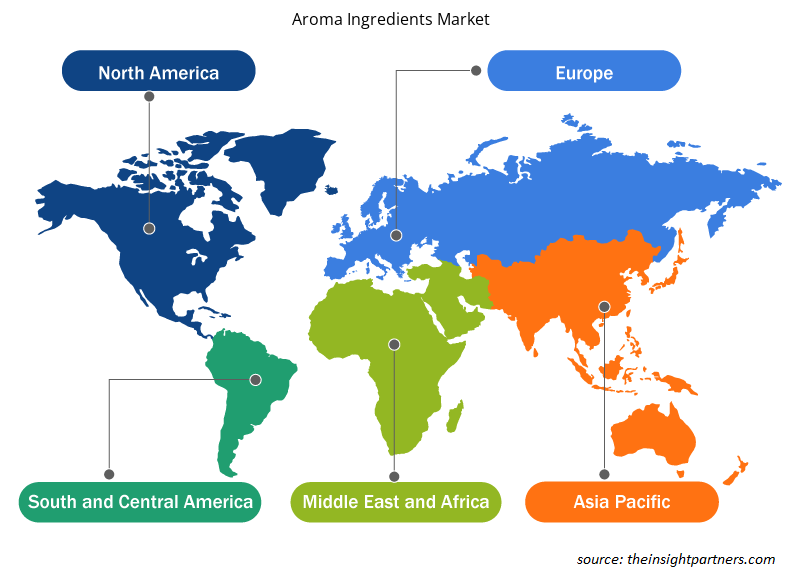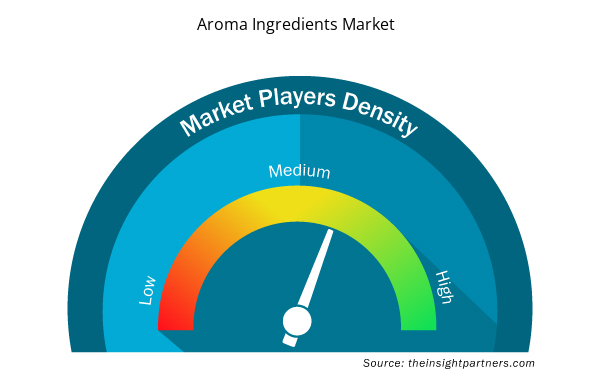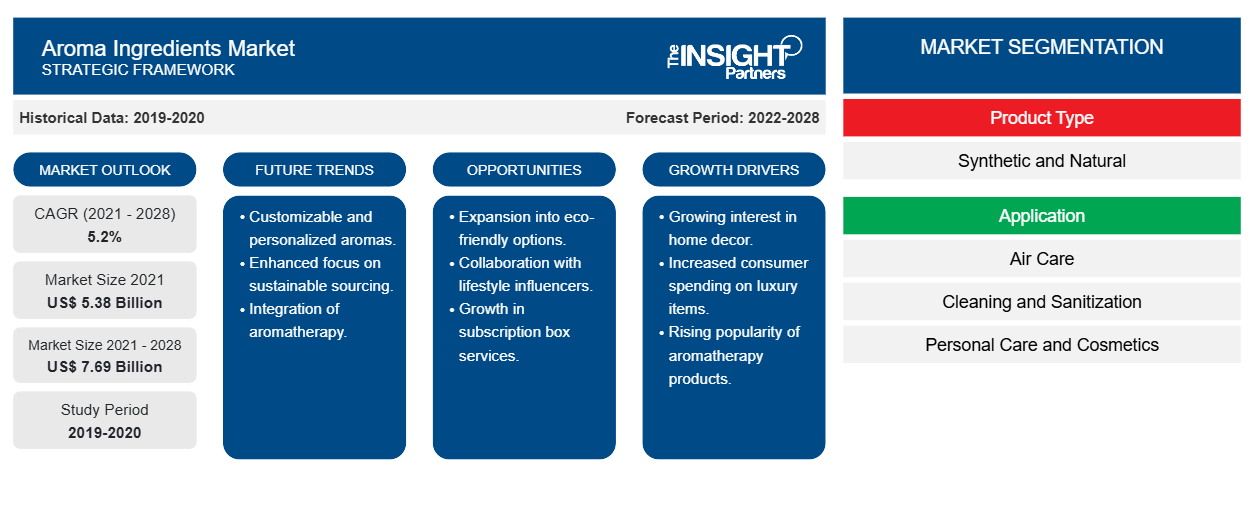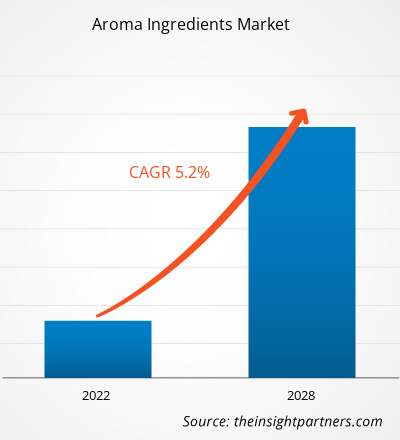El mercado de ingredientes aromáticos se valoró en US$ 5376,90 millones en 2021 y se proyecta que alcance los US$ 7692,62 millones para 2028; se espera que crezca a una CAGR del 5,2% entre 2021 y 2028.
Los ingredientes aromáticos son básicamente compuestos complejos que se añaden a los cosméticos y al cuidado personal, así como a los productos de cuidado del hogar y otros productos para impartir la fragancia deseada. Los ingredientes aromáticos pueden ser naturales o sintéticos. Los ingredientes aromáticos incluyen aceites esenciales, esencias, aislados, oleorresinas, absolutos, productos químicos aromáticos e ingredientes aromáticos especiales, entre otros. La industria del cuidado personal y los cosméticos, en plena transición, ha proporcionado numerosas nuevas oportunidades de crecimiento para el mercado de ingredientes aromáticos y se espera que impulse el mercado durante el período de pronóstico.
En 2020, Asia Pacífico dominó el mercado mundial de ingredientes aromáticos y se espera que mantenga su dominio durante el período de pronóstico. En los últimos años ha habido una mayor conciencia con respecto a la apariencia personal entre las personas en la región de Asia Pacífico, lo que ha llevado a una mayor demanda de productos cosméticos que resultó en el crecimiento del mercado cosmético en la región. El deseo de una imagen personal presentable entre los consumidores asiáticos ha llevado a una mayor conciencia de los hábitos de higiene personal. La creciente preocupación del consumidor por su salud e higiene ha llevado a una mayor demanda de productos de cuidado personal, cosméticos, así como productos de limpieza y desinfección que brinden fragancias o aromas, lo que a su vez lleva a una mayor demanda de ingredientes aromáticos. Además, Asia Pacífico está formada por países como India y China que se han convertido en centros de fabricación para numerosos mercados de uso final que utilizan ingredientes aromáticos. La creciente población en los países en desarrollo de Asia Pacífico junto con el aumento de los ingresos disponibles han llevado a una mayor demanda de productos cosméticos y de cuidado personal. La demanda ha llevado a una mayor producción nacional de productos de cuidado personal, lo que resulta en un mayor consumo de ingredientes aromáticos en la región.
Personalice este informe según sus necesidades
Obtendrá personalización en cualquier informe, sin cargo, incluidas partes de este informe o análisis a nivel de país, paquete de datos de Excel, así como también grandes ofertas y descuentos para empresas emergentes y universidades.
- Obtenga las principales tendencias clave del mercado de este informe.Esta muestra GRATUITA incluirá análisis de datos, desde tendencias del mercado hasta estimaciones y pronósticos.
Perspectivas del mercado
Diversas aplicaciones del ingrediente aromático
El aumento del uso de ingredientes aromáticos en diversas aplicaciones, como el cuidado del aire, las fragancias y los perfumes finos, los productos para el hogar, los alimentos y las bebidas y los productos farmacéuticos, está generando una mayor demanda de ingredientes aromáticos. Las fragancias finas incluyen importantes campos de aplicación, como perfumes, colonias, brumas corporales y desodorantes. Los ingredientes aromáticos son uno de los elementos esenciales utilizados en las formulaciones de fragancias finas. Junto con esto, los ingredientes aromáticos se están utilizando en productos para el hogar, como limpiadores, líquidos para lavar las manos y los platos, suavizantes para el cuidado de la ropa y de telas, toallitas y tintes acuosos. Por lo tanto, una mayor aplicación de ingredientes aromáticos impulsará el crecimiento del mercado de ingredientes aromáticos.dishwashing liquids, laundry care and fabric softeners,
Información sobre el tipo de producto
Según el tipo de producto, el mercado de ingredientes aromáticos se segmenta en naturales y sintéticos. En 2020, el segmento natural fue el de mayor crecimiento en el mercado de ingredientes aromáticos. El aumento de las preocupaciones sanitarias relacionadas con los productos químicos sintéticos ha provocado una mayor demanda de ingredientes aromáticos naturales por parte de los consumidores. Sin embargo, los ingredientes aromáticos sintéticos son comparativamente más fáciles de producir a gran escala y, al mismo tiempo, mantienen la misma calidad en todos los lotes. Por lo tanto, la calidad constante de los ingredientes sintéticos ha dado como resultado una mayor participación en el mercado debido a su uso expansivo, especialmente en la industria de bienes de consumo de rápido movimiento.
Takasago International Corporation; BASF SE; Firmenich SA; Givaudan SA; International Flavors & Fragrances Inc.; Robertet Group; Symrise; Mane; Zhejiang NHU Co., Ltd.; y Phoenix Aromas & Essential Oils, LLC; se encuentran entre los actores clave que operan en el mercado de ingredientes aromáticos. Los principales actores adoptan varias estrategias, como fusiones y adquisiciones y lanzamientos de productos, para expandir su presencia geográfica y su base de consumidores. International Corporation; BASF SE; Firmenich S.A.; Givaudan S.A.; International Flavors & Fragrances Inc.; Robertet Group; Symrise; Mane; Zhejiang NHU Co., Ltd.; and Phoenix Aromas & Essential Oils, LLC; are among the key players operating in the aroma ingredients market. The leading players adopt several strategies, such as mergers & acquisitions and product launches, to expand their geographic presence and consumer base.
Perspectivas regionales del mercado de ingredientes aromáticos
Los analistas de Insight Partners explicaron en detalle las tendencias y los factores regionales que influyen en el mercado de ingredientes aromáticos durante el período de pronóstico. Esta sección también analiza los segmentos y la geografía del mercado de ingredientes aromáticos en América del Norte, Europa, Asia Pacífico, Oriente Medio y África, y América del Sur y Central.

- Obtenga datos regionales específicos para el mercado de ingredientes aromáticos
Alcance del informe de mercado de ingredientes aromáticos
| Atributo del informe | Detalles |
|---|---|
| Tamaño del mercado en 2021 | 5.380 millones de dólares estadounidenses |
| Tamaño del mercado en 2028 | 7.69 mil millones de dólares estadounidenses |
| CAGR global (2021-2028) | 5,2% |
| Datos históricos | 2019-2020 |
| Período de pronóstico | 2022-2028 |
| Segmentos cubiertos | Por tipo de producto
|
| Regiones y países cubiertos | América del norte
|
| Líderes del mercado y perfiles de empresas clave |
|
Densidad de actores del mercado de ingredientes aromáticos: comprensión de su impacto en la dinámica empresarial
El mercado de ingredientes aromáticos está creciendo rápidamente, impulsado por la creciente demanda de los usuarios finales debido a factores como la evolución de las preferencias de los consumidores, los avances tecnológicos y una mayor conciencia de los beneficios del producto. A medida que aumenta la demanda, las empresas amplían sus ofertas, innovan para satisfacer las necesidades de los consumidores y aprovechan las tendencias emergentes, lo que impulsa aún más el crecimiento del mercado.
La densidad de actores del mercado se refiere a la distribución de las empresas o firmas que operan dentro de un mercado o industria en particular. Indica cuántos competidores (actores del mercado) están presentes en un espacio de mercado determinado en relación con su tamaño o valor total de mercado.
Las principales empresas que operan en el mercado de ingredientes aromáticos son:
- Corporación Internacional Takasago
- BASF SE
- Firmenich SA
- Givaudan SA
- Sabores y fragancias internacionales Inc.
Descargo de responsabilidad : Las empresas enumeradas anteriormente no están clasificadas en ningún orden particular.

- Obtenga una descripción general de los principales actores clave del mercado de ingredientes aromáticos
Informe Destacado
- Tendencias progresivas en la industria de ingredientes aromáticos para ayudar a los actores a desarrollar estrategias efectivas a largo plazo
- Estrategias de crecimiento empresarial adoptadas por las empresas para asegurar el crecimiento en los mercados desarrollados y en desarrollo
- Análisis cuantitativo del mercado mundial de ingredientes aromáticos de 2019 a 2028
- Estimación de la demanda de ingredientes aromáticos en diversas industrias
- Análisis de Porter para ilustrar la eficacia de los compradores y proveedores que operan en la industria para predecir el crecimiento del mercado.
- Desarrollos recientes para comprender el escenario competitivo del mercado y la demanda de los ingredientes aromáticos.
- Tendencias y perspectivas del mercado junto con los factores que impulsan y restringen el crecimiento del mercado de ingredientes aromáticos
- Comprensión de las estrategias que sustentan el interés comercial en relación con el crecimiento del mercado global de ingredientes aromáticos, ayudando en el proceso de toma de decisiones.
- Tamaño del mercado de ingredientes aromáticos en varios nodos del mercado
- Descripción detallada y segmentación del mercado global de ingredientes aromáticos, así como su dinámica industrial.
- Tamaño del mercado de ingredientes aromáticos en varias regiones con oportunidades de crecimiento prometedoras
El "Análisis del mercado global de ingredientes aromáticos hasta 2028" es un estudio especializado y profundo de la industria de productos químicos y materiales con un enfoque especial en el análisis de tendencias del mercado global de ingredientes aromáticos. El informe tiene como objetivo proporcionar una descripción general del mercado con una segmentación detallada del mercado. El mercado de ingredientes aromáticos está segmentado en función del tipo de producto, la aplicación y la geografía. Según el tipo de producto, el mercado se segmenta en natural y sintético. Según la aplicación, el mercado se segmenta en cuidado del aire, limpieza y desinfección, cuidado personal y cosméticos, fragancias y perfumes finos, y otros. Según la geografía, el mercado está segmentado en cinco regiones principales: América del Norte, Europa, Asia Pacífico, Oriente Medio y África, y América del Sur y Central.
Perfiles de empresas
- Corporación Internacional Takasago
- BASF SE
- Firmenich SA
- Givaudan SA
- Sabores y fragancias internacionales Inc.
- Grupo Robertet
- Simulación
- Melena
- Compañía NHU de Zhejiang, Ltd.
- Aromas y aceites esenciales Phoenix, LLC.
- Análisis histórico (2 años), año base, pronóstico (7 años) con CAGR
- Análisis PEST y FODA
- Tamaño del mercado Valor/volumen: global, regional, nacional
- Industria y panorama competitivo
- Conjunto de datos de Excel



Report Coverage
Revenue forecast, Company Analysis, Industry landscape, Growth factors, and Trends

Segment Covered
This text is related
to segments covered.

Regional Scope
North America, Europe, Asia Pacific, Middle East & Africa, South & Central America

Country Scope
This text is related
to country scope.
Preguntas frecuentes
Aroma ingredients are extensively used to create a wide range of fragrances. Increased healthcare awareness and disposable income have increased demand for consumer goods such as soaps, hand wash, sanitizers, detergents and toiletries. Although, the expansion of the personal care and household care industries significantly contributes to the growth of the aroma ingredient market. Manufacturers focus on increasing natural ingredients for the flavor and fragrance industry to ensure the sustainable sourcing of raw materials.
In 2020, the natural segment accounted for the fastest-growing segment. Natural aroma ingredients are extracted from natural sources, including wood, spices, flowers, and fruits. The rising awareness of the negative effects of synthetic ingredients on human health has increased the demand for natural and bio-based aroma ingredients.
Based on application, personal care and cosmetics are the fastest-growing segments. Aroma ingredients are extensively used in manufacturing personal care and cosmetics products. Continuous technological developments in the personal care and cosmetics sectors and innovations and research and development expenditures are expected to propel the growth of the aroma ingredient market.
In 2020, the synthetic segment accounted for the largest market share. Synthetic aroma ingredients can reproduce a natural and robust scent without compromising the fragrance to manufacture quality fragrance. It has strong demand in manufacturing soaps, shampoos, body lotions, hair conditioners, and other cosmetic and personal care products.
The major players operating in the global metakaolin market are Takasago International Corporation, BASF SE, Firmenich S.A., Givaudan S.A., International Flavors & Fragrances Inc., Robertet Group, Symrise, Mane, Zhejiang NHU Co., Ltd., and Phoenix Aromas & Essential Oils, LLC.
In 2020, Asia Pacific accounted for the largest share of the global aroma ingredient market. The aroma ingredient industry is anticipated to expand faster due to increasing awareness of personal care and hygiene.
Trends and growth analysis reports related to Chemicals and Materials : READ MORE..
The List of Companies - Aroma Ingredient Market
- Takasago International Corporation
- BASF SE
- Firmenich S.A.
- Givaudan S.A.
- International Flavors & Fragrances Inc.
- Robertet Group
- Symrise
- Mane
- Zhejiang NHU Co., Ltd.
- Phoenix Aromas & Essential Oils, LLC.
The Insight Partners performs research in 4 major stages: Data Collection & Secondary Research, Primary Research, Data Analysis and Data Triangulation & Final Review.
- Data Collection and Secondary Research:
As a market research and consulting firm operating from a decade, we have published and advised several client across the globe. First step for any study will start with an assessment of currently available data and insights from existing reports. Further, historical and current market information is collected from Investor Presentations, Annual Reports, SEC Filings, etc., and other information related to company’s performance and market positioning are gathered from Paid Databases (Factiva, Hoovers, and Reuters) and various other publications available in public domain.
Several associations trade associates, technical forums, institutes, societies and organization are accessed to gain technical as well as market related insights through their publications such as research papers, blogs and press releases related to the studies are referred to get cues about the market. Further, white papers, journals, magazines, and other news articles published in last 3 years are scrutinized and analyzed to understand the current market trends.
- Primary Research:
The primarily interview analysis comprise of data obtained from industry participants interview and answers to survey questions gathered by in-house primary team.
For primary research, interviews are conducted with industry experts/CEOs/Marketing Managers/VPs/Subject Matter Experts from both demand and supply side to get a 360-degree view of the market. The primary team conducts several interviews based on the complexity of the markets to understand the various market trends and dynamics which makes research more credible and precise.
A typical research interview fulfils the following functions:
- Provides first-hand information on the market size, market trends, growth trends, competitive landscape, and outlook
- Validates and strengthens in-house secondary research findings
- Develops the analysis team’s expertise and market understanding
Primary research involves email interactions and telephone interviews for each market, category, segment, and sub-segment across geographies. The participants who typically take part in such a process include, but are not limited to:
- Industry participants: VPs, business development managers, market intelligence managers and national sales managers
- Outside experts: Valuation experts, research analysts and key opinion leaders specializing in the electronics and semiconductor industry.
Below is the breakup of our primary respondents by company, designation, and region:

Once we receive the confirmation from primary research sources or primary respondents, we finalize the base year market estimation and forecast the data as per the macroeconomic and microeconomic factors assessed during data collection.
- Data Analysis:
Once data is validated through both secondary as well as primary respondents, we finalize the market estimations by hypothesis formulation and factor analysis at regional and country level.
- Macro-Economic Factor Analysis:
We analyse macroeconomic indicators such the gross domestic product (GDP), increase in the demand for goods and services across industries, technological advancement, regional economic growth, governmental policies, the influence of COVID-19, PEST analysis, and other aspects. This analysis aids in setting benchmarks for various nations/regions and approximating market splits. Additionally, the general trend of the aforementioned components aid in determining the market's development possibilities.
- Country Level Data:
Various factors that are especially aligned to the country are taken into account to determine the market size for a certain area and country, including the presence of vendors, such as headquarters and offices, the country's GDP, demand patterns, and industry growth. To comprehend the market dynamics for the nation, a number of growth variables, inhibitors, application areas, and current market trends are researched. The aforementioned elements aid in determining the country's overall market's growth potential.
- Company Profile:
The “Table of Contents” is formulated by listing and analyzing more than 25 - 30 companies operating in the market ecosystem across geographies. However, we profile only 10 companies as a standard practice in our syndicate reports. These 10 companies comprise leading, emerging, and regional players. Nonetheless, our analysis is not restricted to the 10 listed companies, we also analyze other companies present in the market to develop a holistic view and understand the prevailing trends. The “Company Profiles” section in the report covers key facts, business description, products & services, financial information, SWOT analysis, and key developments. The financial information presented is extracted from the annual reports and official documents of the publicly listed companies. Upon collecting the information for the sections of respective companies, we verify them via various primary sources and then compile the data in respective company profiles. The company level information helps us in deriving the base number as well as in forecasting the market size.
- Developing Base Number:
Aggregation of sales statistics (2020-2022) and macro-economic factor, and other secondary and primary research insights are utilized to arrive at base number and related market shares for 2022. The data gaps are identified in this step and relevant market data is analyzed, collected from paid primary interviews or databases. On finalizing the base year market size, forecasts are developed on the basis of macro-economic, industry and market growth factors and company level analysis.
- Data Triangulation and Final Review:
The market findings and base year market size calculations are validated from supply as well as demand side. Demand side validations are based on macro-economic factor analysis and benchmarks for respective regions and countries. In case of supply side validations, revenues of major companies are estimated (in case not available) based on industry benchmark, approximate number of employees, product portfolio, and primary interviews revenues are gathered. Further revenue from target product/service segment is assessed to avoid overshooting of market statistics. In case of heavy deviations between supply and demand side values, all thes steps are repeated to achieve synchronization.
We follow an iterative model, wherein we share our research findings with Subject Matter Experts (SME’s) and Key Opinion Leaders (KOLs) until consensus view of the market is not formulated – this model negates any drastic deviation in the opinions of experts. Only validated and universally acceptable research findings are quoted in our reports.
We have important check points that we use to validate our research findings – which we call – data triangulation, where we validate the information, we generate from secondary sources with primary interviews and then we re-validate with our internal data bases and Subject matter experts. This comprehensive model enables us to deliver high quality, reliable data in shortest possible time.


 Obtenga una muestra gratuita de este informe
Obtenga una muestra gratuita de este informe